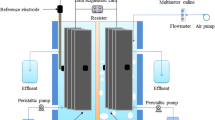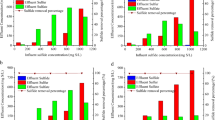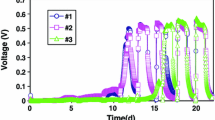Abstract
The effect of operating modes on the simultaneous sulfide and nitrate removal were studied in two-chamber microbial fuel cells (MFCs). The batch and continuous operating modes were compared and evaluated in terms of substrate removal and electricity generation. Upon gradual increase in the influent sulfide concentration from 60 to 1,020 S mg L−1, and the hydraulic retention time decrease from 17.2 to 6 h, the MFC accomplished a good substrate removal efficiency whereby nitrogen and sulfate were the main end products. The removal efficiency of the MFC in the continuous mode was much higher than that in the batch mode, and its current densities in the continuous mode were more stable and higher than in the batch mode, which could be explained by the linear relationship between electrons released by the substrates and accepted on the electrodes. The electricity output in the continuous mode of the MFC was higher than that in the batch mode. MFC's operation in the continuous mode was a better strategy for the simultaneous treatment of sulfide and nitrate.





Similar content being viewed by others
References
Aelterman P, Rabaey K, Clauwaert P, Verstraete W (2006) Microbial fuel cells for wastewater treatment. Water Sci Technol 54(8):9–15. doi:10.2166/wst.2006.702
APHA, Awwa, WPCF (1998) Standard methods for the examination of water and wastewater, 20th edn. American Public Health Association, Washington, DC
Cai J, Zheng P (2013) Simultaneous anaerobic sulfide and nitrate removal in microbial fuel cell. Bioresour Technol 128:760–764. doi:10.1016/j.biortech.2012.08.046
Cai J, Zheng P, Zhang J, Xie Z, Li W, Sun P (2013) Simultaneous anaerobic sulfide and nitrate removal coupled with electricity generation in Microbial Fuel Cell. Bioresour Technol 129:224–228. doi:10.1016/j.biortech.2012.11.008
Chung K, Okabe S (2009) Continuous power generation and microbial community structure of the anode biofilms in a three-stage microbial fuel cell system. Appl Microbiol Biotechnol 83(5):965–977. doi:10.1007/s00253-009-1990-z
Cirne DG, van der Zee FP, Fernandez-Polanco M, Fernandez-Polanco F (2008) Control of sulphide during anaerobic treatment of S-containing wastewaters by adding limited amounts of oxygen or nitrate. Rev Environ Sci Bio/Technol 7(2):93–105. doi:10.1007/s11157-008-9128-9
Du Z, Li H, Gu T (2007) A state of the art review on microbial fuel cells: a promising technology for wastewater treatment and bioenergy. Biotechnol Adv 25(5):464–482. doi:10.1016/j.biotechadv.2007.05.004
Garcia-de-Lomas J, Corzo A, Portillo MC, Gonzalez JM, Andrades JA, Saiz-Jimenez C, Garcia-Robledo E (2007) Nitrate stimulation of indigenous nitrate-reducing, sulfide-oxidising bacterial community in wastewater anaerobic biofilms. Water Res 41(14):3121–3131. doi:10.1016/j.watres.2007.04.004
Habermann W, Pommer EH (1991) Biological fuel cells with sulphide storage capacity. Appl Microbiol Biotechnol 35(1):128–133
Jin R, Yang GF, Zhang QQ, Ma C, Yu JJ, Xing BS (2013) The effect of sulfide inhibition on the ANAMMOX process. Water Res 47(3):1459–1469. doi:10.1016/j.watres.2012.12.018
Jing C, Ping Z, Mahmood Q (2010) Influence of various nitrogenous electron acceptors on the anaerobic sulfide oxidation. Bioresour Technol 101(9):2931–2937. doi:10.1016/j.biortech.2009.11.047
Kim H-W, Nam J-Y, Shin H-S (2011) Ammonia inhibition and microbial adaptation in continuous single-chamber microbial fuel cells. J Power Sources 196(15):6210–6213. doi:10.1016/j.jpowsour.2011.03.061
Lee C, Ho K, Lee D, Su A, Chang J (2012) Electricity harvest from nitrate/sulfide-containing wastewaters using microbial fuel cell with autotrophic denitrifier, Pseudomonas sp C27. Int J Hydrogen Energ 37(20):15827–15832. doi:10.1016/j.ijhydene.2012.01.092
Logan BE, Hamelers B, Rozendal RA, Schrorder U, Keller J, Freguia S, Aelterman P, Verstraete W, Rabaey K (2006) Microbial fuel cells: methodology and technology. Environ Sci Technol 40(17):5181–5192. doi:10.1021/es0605016
Mahmood Q, Zheng P, Cai J, Hayat Y, Hassan MF, Wu DL, Hu BL (2007) Sources of sulfide in waste streams and current biotechnologies for its removal. J Zhejiang Univ Sci A 8(7):1126–1140. doi:10.1631/jzus.2007.A1126
Mahmood Q, Zheng P, Cai J, Wu D, Hu B, Li J (2007) Anoxic sulfide biooxidation using nitrite as electron acceptor. J Hazard Mater 147(1–2):249–256. doi:10.1016/j.jhazmat.2007.01.002
Oliveira VB, Simões M, Melo LF, Pinto AMFR (2013) Overview on the developments of microbial fuel cells. Biochem Eng J 73:53–64. doi:10.1016/j.bej.2013.01.012
Pant D, Van Bogaert G, Diels L, Vanbroekhoven K (2010) A review of the substrates used in microbial fuel cells (MFCs) for sustainable energy production. Bioresour Technol 101(6):1533–1543. doi:10.1016/j.biortech.2009.10.017
Rahimnejad M, Ghoreyshi AA, Najafpour G, Jafary T (2011) Power generation from organic substrate in batch and continuous flow microbial fuel cell operations. Appl Energy 88(11):3999–4004. doi:10.1016/j.apenergy.2011.04.017
Zhang L, De Schryver P, De Gusseme B, De Muynck W, Boon N, Verstraete W (2008) Chemical and biological technologies for hydrogen sulfide emission control in sewer systems: a review. Water Res 42(1–2):1–12. doi:10.1016/j.watres.2007.07.013
Acknowledgments
The authors wish to thank the National Natural Science Foundation of China (no. 51278457) and the Special Foundation of Young Scientists of Zhejiang Gongshang University (QZ11-7) for financial support of this study.
Author information
Authors and Affiliations
Corresponding authors
Rights and permissions
About this article
Cite this article
Cai, J., Zheng, P., Qaisar, M. et al. Effect of operating modes on simultaneous anaerobic sulfide and nitrate removal in microbial fuel cell. J Ind Microbiol Biotechnol 41, 795–802 (2014). https://doi.org/10.1007/s10295-014-1425-4
Received:
Accepted:
Published:
Issue Date:
DOI: https://doi.org/10.1007/s10295-014-1425-4




